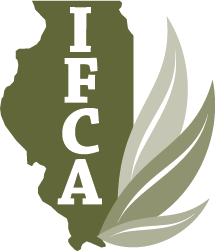Fall Ammonia
As we approach the middle of October, thoughts begin to turn to the yearly question "When Can I Start to Apply Fall Ammonia?"
The following best management practices reflect what we have learned in 9 years of NREC funded research, performed on actual farmer fields over tile drainage. These BMPs are also part of both the Illinois Nutrient Loss Reduction Strategy (INLRS) and the University of Illinois recommendations. The BMPs are as follows:
1. Use the Right Nitrogen Rate and do not apply the full rate in the fall. We recommend saving 30-40% of the rate to be applied pre-plant or side-dress. This helps to manage both environmental and agronomic risk since we do not know what the weather will be over the next six months. The Illinois Nitrogen Rate Calculator is updated each year with the results of dozens of nitrogen rate trials performed throughout the State. The current recommended rates for corn following soybean are:
Northern Illinois: 171 - 194 lbs. per acre
Central Illinois: 181 - 200 lbs. per acre
Southern Illinois: 200 - 225 lbs. per acre; NITROGEN SHOULD NOT BE FALL APPLIED IN SOUTHERN ILLINOIS
2. Wait until mid-day soil temperatures in bare soil at the 4" depth is 50 degrees and the weather forecast indicates temperatures will not rebound, but rather will continue to cool. IFCA will start posting the State Water Survey soil temperature each day starting on Monday on the IFCA homepage, www.ifca.com. But it is always recommended you take the soil temperature in field yourself, as the temperatures posted on the website are not provided in each county.
3. Use a USEPA labeled nitrification inhibitor with all fall-applied ammonia (N-Serv and Centuro). These products are registered as pesticides because they inhibit bacterial activity that can convert ammonium to nitrate. These bacteria are active until the soil freezes. The inhibitor is intended to provide protection against nitrification in the late fall, early winter, and spring. This chart shows how fast ammonium converts to nitrate at various temperatures. Protecting ammonia with a nitrification inhibitor helps a great deal, but when soils remain warm that protection is much less effective.
In priority watersheds including Lake Springfield, Lake Decatur, Lake Vermilion and Lake Bloomington, it is especially important to follow these guidelines, or consider applying nitrogen in the spring in fields within these watersheds. We continue to see nitrate levels rise in late winter and early spring in these drinking water supplies, sometimes to concerning levels.
NREC funded research shows that there is no yield penalty for applying N in the fall, but there is a water quality penalty especially in tile drained fields. NREC research shows that fall applied N loses up to 12 lbs. more per acre than N applied in the spring.
The UI published a bulletin on October 6th discussing fall applied N. Click Here to read.
IFCA will be hosting an online webinar Tuesday, October 26th starting at 8:00 a.m. Central Time, led by Dr. Emerson Nafziger on nitrogen management. Data produced from several research projects focusing on nitrogen research from the 2021 corn season will drive the discussion. This online webinar is offering 1 CEU in Nutrient Management. Click the link below to register:
IFCA recognizes that following these guidelines can create economic challenges for retailers and farmers. We also understand that ag retailers are under immense pressure from farmers to apply ammonia this fall with threats of nitrogen prices growing in the spring. We all remember three years ago when many waited for soil temperatures to drop to 50 degrees, only to be rained out and left with no opportunity to apply nitrogen at all. This was followed by ammonia contracts being cancelled at year-end. The old saying "no good deed goes unpunished" would certainly fit here. Despite this, we must keep in mind the many eyes on our industry, and the commitments to adhere to voluntary measures to reduce nutrient losses in accordance with the INLRS.
As always, contact IFCA with any questions or concerns. We are here for you, as well as to ensure the good practices of our industry members are shared with other water quality stakeholders, even when times are difficult.
